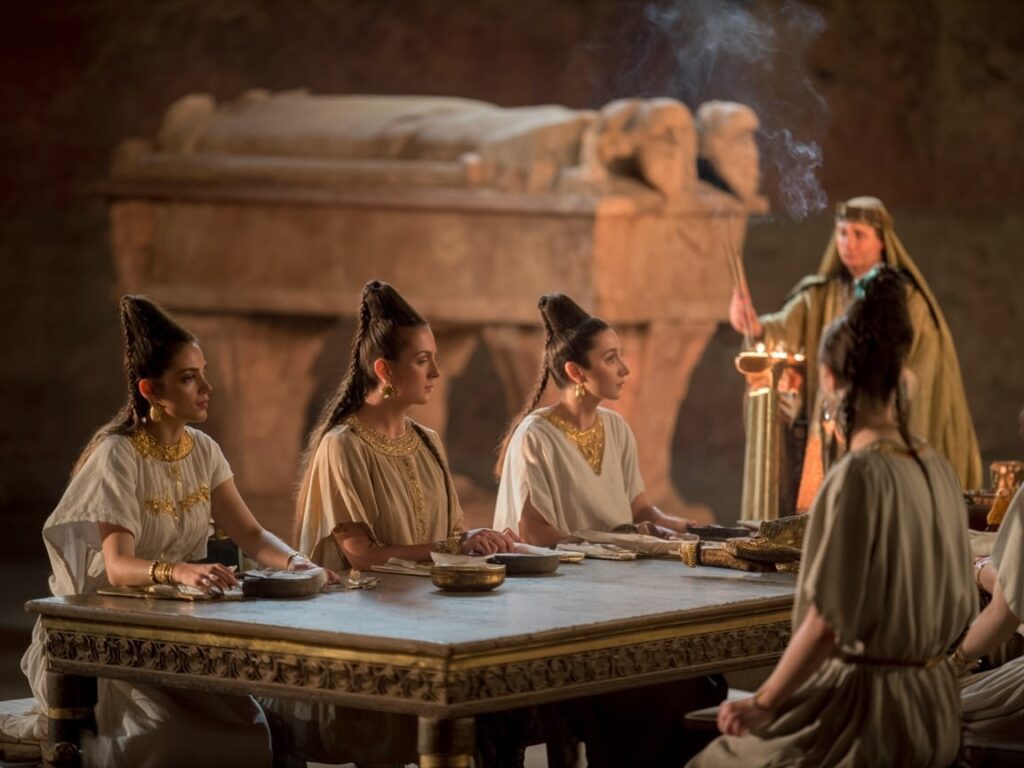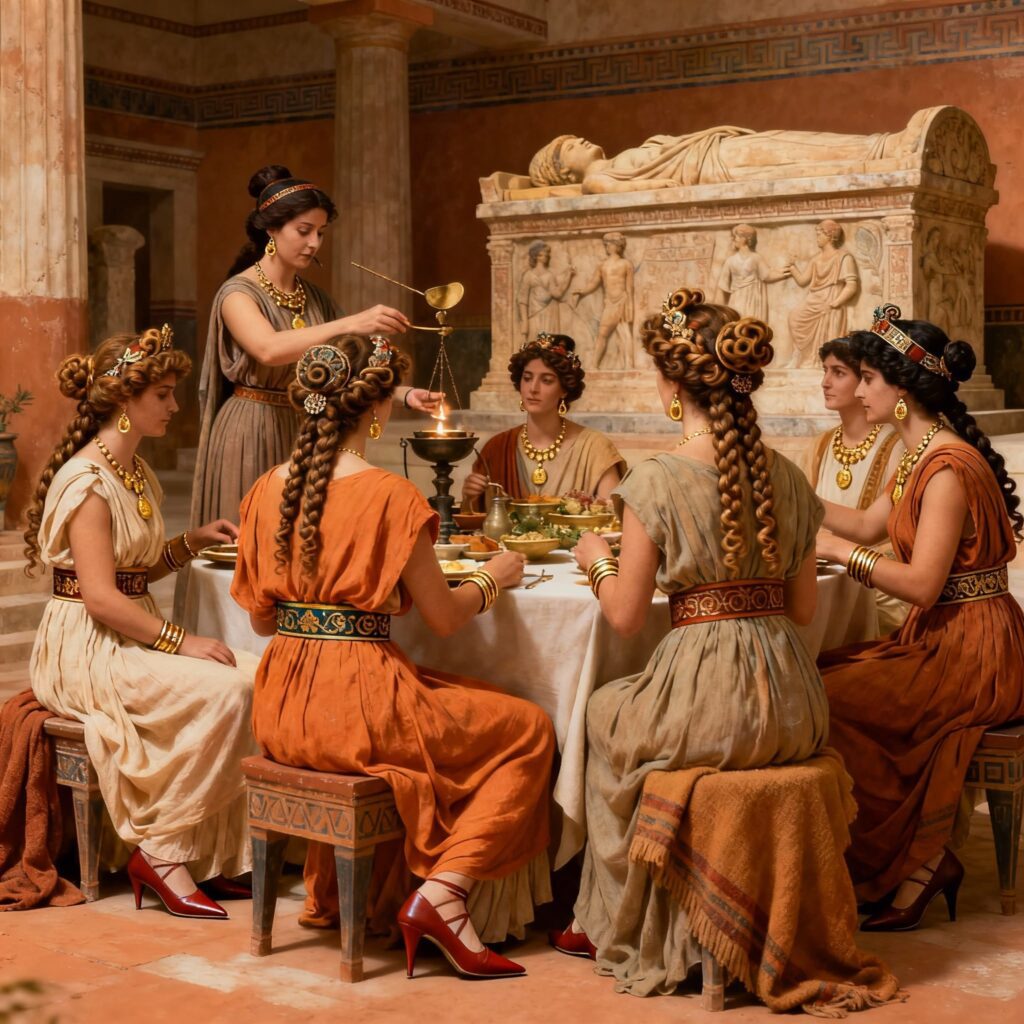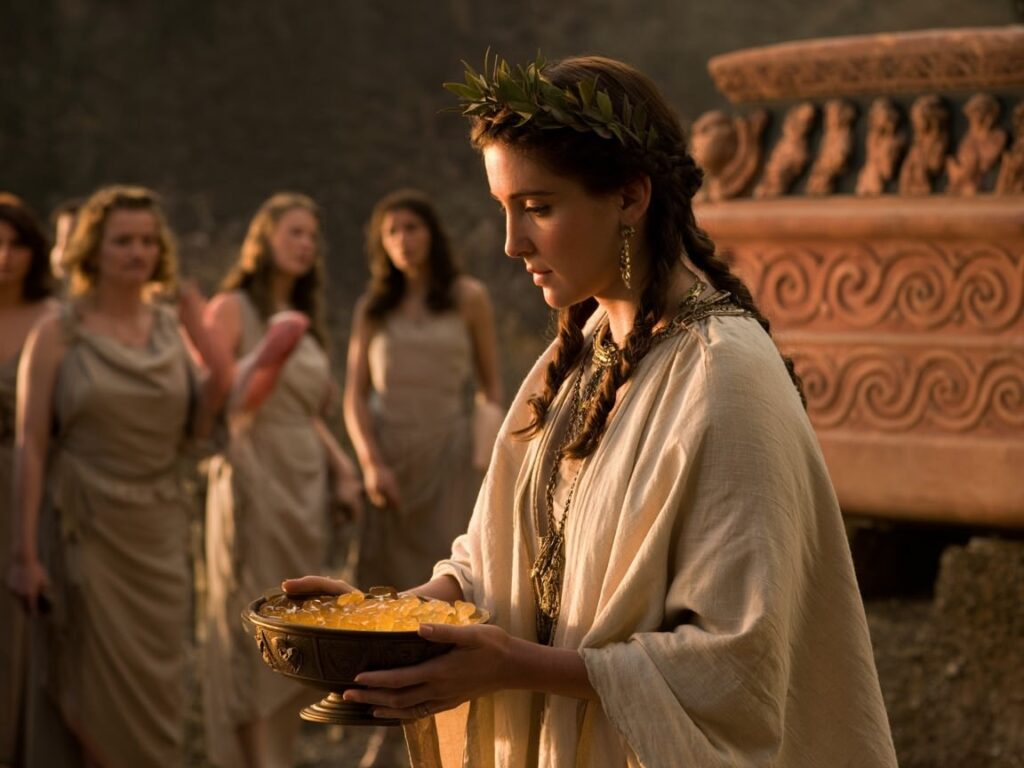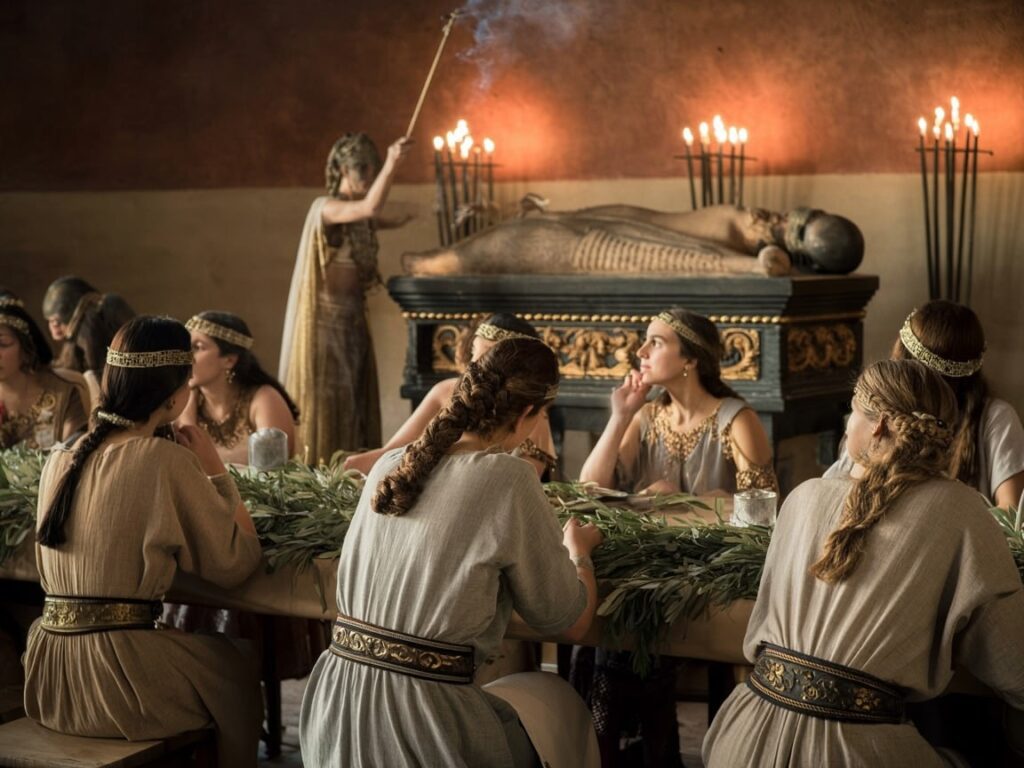The Etruscans were a powerful and culturally rich civilization in ancient Italy, flourishing between the 8th and 3rd centuries BCE. Their society preceded and heavily influenced the early Romans, shaping aspects of religion, governance, and daily life. Among their most notable contributions is the distinctive role of Etruscan women, who held social freedoms and public visibility uncommon in other ancient cultures.
Unlike Greek and later Roman women, who were often confined to domestic spheres and limited in public engagement, Etruscan women participated actively in banquets, religious ceremonies, and social events. Their status was marked by respect and autonomy, setting them apart in ancient Mediterranean societies.
This article explores The Influence of Etruscan Women on Early Roman Society and Fashion, highlighting how their unique position shaped early Roman cultural practices, gender roles, and styles that resonated far beyond their time.
The Unique Social Position of Etruscan Women
Etruscan society distinguished itself by granting women a respected and influential status rarely seen in other ancient cultures. Unlike many contemporary civilizations, Etruscan women were not confined to the domestic sphere but actively engaged in public life.
Key aspects of women’s social status in Etruscan society include:
- Political Participation: While direct political power was generally reserved for men, Etruscan women could exert influence through familial connections and social networks. Their presence at public events allowed them to shape opinions and alliances indirectly.
- Public Visibility: Women frequently attended banquets, religious ceremonies, and social gatherings alongside men. This visibility signified equality and mutual respect within these settings.
- Cultural Influence: Participation in religious rites positioned women as essential figures in maintaining spiritual and societal order.
Comparison with Greek and later Roman gender roles reveals stark differences:
- In classical Greece, respectable women were largely excluded from public events and restricted to household roles.
- Roman women under later patriarchal norms faced limitations on their public presence and legal rights.
However, it’s crucial to note that the unique position of Etruscan women did not last indefinitely. With the rise of Roman influence, many aspects of Etruscan life underwent significant changes. This transition is emblematic of a broader trend where the influence of Roman society on Western civilization became evident, reshaping cultural norms and social structures across various domains.
Etruscan women’s active involvement in social and ceremonial life challenged typical gender boundaries of the ancient world. This unique position fostered a culture where female agency was acknowledged and valued, setting a foundation that would resonate, albeit transformed, in early Roman traditions.

Economic Independence and Property Rights
Etruscan women held uncommon economic privileges in the ancient world, distinguished by their ability to engage actively in property ownership and economic management. Unlike their Greek and later Roman counterparts, these women could own land and other assets independently, a right that granted them significant control over family wealth and resources.
Key aspects of their economic independence include:
- Property Ownership: Etruscan women legally possessed property, enabling them to inherit, buy, and sell estates without male intermediaries. This autonomy allowed them to wield considerable influence within both their households and broader community structures.
- Household Management: Managing the household extended beyond domestic duties; it involved overseeing servants, finances, and estate affairs. Women often directed these operations with authority equal to men.
- Involvement in Trade: Archaeological findings suggest Etruscan women participated in trade activities, either directly or through managing family businesses. Their presence in commercial transactions indicates active engagement in the economic life of Etruscan cities. In fact, understanding the trade and economy in ancient Rome, which was foundational to its vast empire, reveals the significance of economic practices that shaped one of history’s most powerful civilizations.
This degree of financial autonomy translated into broader social influence. Women’s property rights challenged traditional patriarchal norms by providing them with tangible power and visibility in public spheres. Their participation in economic activities reinforced their respected status while shaping early societal structures where gender roles were less rigidly defined than in neighboring cultures. Such legal rights of women in history reflect a broader trend of women’s empowerment seen across various civilizations. Moreover, exploring the women’s roles in antiquity further highlights the significant impact they had on socio-economic structures during that era.

Religious Roles and Spiritual Influence
Etruscan women held prominent positions as priestesses, a role that granted them significant spiritual authority within their communities. Their involvement in religious ceremonies was not merely symbolic; they actively led rituals that were crucial to social cohesion and the maintenance of divine favor. These priestesses performed rites that involved divination, sacrifices, and public prayers, demonstrating a level of religious participation rarely afforded to women in contemporary Greek or early Roman societies.
- Priestesses acted as mediators between the gods and the people, entrusted with interpreting omens and guiding communal decisions.
- Their presence at sacred events underscored the respect Etruscan culture had for female spiritual leadership.
- Participation in these ceremonies extended beyond ritualistic duties to influence cultural norms and values through religious teachings.
This spiritual leadership allowed Etruscan women to shape cultural practices directly, embedding their influence into traditions that permeated family life and public celebrations. Their role reinforced a vision of gender complementarity in both sacred and social contexts.
The influence of these religious roles is an essential facet of The Influence of Etruscan Women on Early Roman Society and Fashion, revealing how spiritual authority translated into lasting cultural impact. The rituals performed by these priestesses often mirrored those found in Roman religious practices, which were deeply connected to the divine through similar rituals and sacrifices. However, as Etruscan influences waned and political instability began to undermine the foundations of Rome, the cultural impact of these women’s roles became even more pronounced, shaping not just religious practices but also the very fabric of society itself.
Artistic Representation: The Sarcophagus of the Spouses
The Sarcophagus of the Spouses, discovered in Cerveteri and dating back to the 6th century BCE, is a powerful archaeological evidence of Etruscan views on gender equality within marriage. This terracotta sarcophagus features a reclining man and woman sharing a banquet couch, symbolizing partnership and mutual respect rarely seen in ancient art.
Key features illustrating this unique representation include:
- Physical closeness: The couple’s intertwined arms and relaxed postures convey emotional intimacy and companionship.
- Equal prominence: Both figures receive equal artistic attention, highlighting the woman’s significant social status alongside her male partner.
- Expressive faces: Smiling expressions suggest warmth and affection, contrasting sharply with the formal or distant depictions typical in contemporary Greek funerary art.
Greek art from the same period often emphasizes strict gender segregation, portraying women as passive or absent in public and domestic scenes. The Etruscan depiction challenges these norms by celebrating a shared social and emotional role between spouses. This piece not only reflects marital equality but also offers insights into broader societal attitudes toward women’s visibility and influence in Etruscan culture.
Interestingly, this unique representation of marital dynamics is quite different from what we see in later Roman sculpture. As Men of Pompeii notes, Roman sculpture evolved significantly over time, showcasing a distinct focus on realism and the portrayal of power. This art form served not only as artistic expressions but also as instruments for political propaganda and religious devotion.

Etruscan Fashion: Clothing, Jewelry, and Hairstyles
Etruscan women expressed their social status and identity through distinctive Etruscan clothing, jewelry, and hairstyles that set them apart in the ancient world. Their typical attire often included garments similar to the Greek chiton or peplos, but with unique adaptations that reflected local tastes and customs.
Clothing
Etruscan women favored flowing tunics made from fine linen or wool. These garments were frequently layered and secured with ornate belts or pins, allowing for both elegance and mobility. Sleeves varied in length, sometimes featuring intricate embroidery or patterned designs that showcased craftsmanship. Such detailed craftsmanship in clothing is well-documented in various sources, including this comprehensive guide on Etruscan fashion.
Footwear
Pointed shoes with raised toes represented a fashionable statement distinctive to Etruscan dress. These shoes appeared in tomb paintings and sculptures, indicating their popularity among women of higher social ranks.
Hairstyles
Elaborate hairstyles were an important part of Etruscan fashion identity. Women styled their hair with curls, braids, and sometimes added ornamental hairpieces. These hairstyles were carefully maintained and often signaled social standing or religious roles.
Jewelry
Gold pendants, earrings, bracelets, and necklaces served as clear symbols of wealth and influence. Jewelry designs incorporated motifs from nature—such as leaves, animals, and flowers—displaying both artistic skill and cultural symbolism. The use of precious metals and stones reinforced the wearer’s prominence within society.
Etruscan fashion influenced early Roman styles by inspiring a blend of elegance and symbolic adornment that emphasized personal status alongside communal identity. This influence is evident in the transition from Etruscan to Roman fashion styles as detailed in this insightful article. The attention to detail in dress and accessories reflected a culture where women’s appearance was intertwined with their social power and public presence.

From Etruscan to Roman: The Transition in Gender Roles and Fashion Trends
The process of Romanization after 340 BCE marked a significant shift in the status and roles of women, particularly those influenced by Etruscan traditions. The privileges that Etruscan women once enjoyed—such as public presence, property rights, and social autonomy—gradually diminished under the emerging Roman patriarchal system.
Key changes included:
- Reduction in public visibility: Unlike the active participation of Etruscan women in banquets and religious ceremonies, early Roman women were more confined to domestic spaces.
- Shift in gender roles: The strong presence of Etruscan women as social equals transitioned into more restricted roles emphasizing motherhood and wifely duties.
- Loss of economic independence: Property ownership and management rights for women became limited as Roman law increasingly favored male guardianship.
Despite these changes, echoes of Etruscan ideals persisted among early Roman upper-class women. Their roles retained aspects of family prominence and social presence inherited from Etruscan culture:
- Maintaining influence within the household through managing family affairs.
- Upholding the family’s honor as visible representatives in social functions.
- Fashion elements such as jewelry and hairstyles continued to reflect Etruscan sophistication.
The influence of Etruscan women on early Roman society and fashion remains evident, especially through these remnants of elevated female status that subtly shaped early Rome’s evolving gender dynamics. This interplay between cultures is further reflected in the masterpieces of Roman art, which showcases a blend of artistic influences from various cultures, including Etruscan.
Marital Equality, Family Identity, and Cultural Practices in Early Rome
Shared Activities and Burial Customs as Expressions of Marital Equality
Marital equality found expression in early Roman social life through shared activities and burial customs that underscored partnership. Couples often appeared together at banquets and ceremonies, reflecting a relationship based on mutual respect rather than strict hierarchy. This public visibility of women alongside men was a significant marker of marital equality inherited from Etruscan traditions.
Evidence from Family Tombs: Honoring Individual Identities and Contributions
Family tombs provide vivid evidence of this cultural value. Unlike the later Roman practice where women’s roles were minimized, early graves frequently included both spouses with elaborate goods that honored their individual identities and contributions. These grave goods—mirrors, jewelry, and personal items—signified respect for women’s autonomy within the family unit.
Matronymics: Emphasizing Women’s Importance in Civil Records
The use of matronymics alongside personal names further distinguished women’s importance in civil records. This practice recorded lineage or civil status through the mother’s name as well as the father’s, emphasizing matrilineal recognition. It highlights how family identity was not solely patriarchal but acknowledged women as key figures in heritage and social standing.
Challenging Assumptions About Gender Roles in Ancient Rome
Such cultural practices reveal a social fabric where marital equality was more than idealistic—it shaped how families presented themselves publicly and how society recognized women’s roles within those units. This nuanced view challenges later assumptions about rigid gender roles in ancient Rome by tracing its roots to Etruscan influence on family identity and social customs.
Conclusion
Etruscan women had a significant impact on early Roman culture, as seen in the changes they inspired. Their influence challenges common beliefs about ancient gender roles and highlights a time when women had power, respect, and visibility. Understanding their contributions gives us a deeper understanding of The Influence of Etruscan Women on Early Roman Society and Fashion.
Key takeaways include:
- Etruscan women’s active public participation set precedents for social and religious roles.
- Their economic independence and property rights expanded the scope of female agency.
- Fashion and familial customs originating from Etruscan traditions shaped early Roman identity.
Appreciating these elements deepens our insight into ancient history and encourages a reevaluation of women’s roles in shaping civilizations long before later restrictive norms took hold. The story of Etruscan women is crucial for understanding the foundations of early Roman society.
FAQs (Frequently Asked Questions)
Who were the Etruscans and what was their historical significance?
The Etruscans were an ancient civilization in Italy preceding Roman dominance, known for their unique culture, social structures, and influence on early Roman society and fashion.
How did the social status of Etruscan women differ from that of Greek and later Roman women?
Etruscan women held a respected and influential position, actively participating in public life such as banquets and religious ceremonies, contrasting with the more restricted roles of Greek and later Roman women.
What economic rights did Etruscan women possess in their society?
Etruscan women could independently own property, manage households, engage in trade, and participate in economic affairs, granting them significant autonomy and influence within their society.
In what ways did Etruscan women contribute to religious and spiritual life?
Etruscan women served as esteemed priestesses who participated in religious rituals and ceremonies, exerting considerable spiritual leadership that influenced cultural practices.
What does the Sarcophagus of the Spouses reveal about gender roles in Etruscan society?
The 6th-century BCE Sarcophagus of the Spouses symbolizes marital equality and partnership through its artistic depiction of emotional intimacy between man and woman, highlighting gender equality uncommon in contemporary cultures.
How did Etruscan women’s fashion influence early Roman society?
Etruscan women’s distinctive clothing such as chitons or peplos-style garments, pointed shoes with raised toes, elaborate hairstyles, and use of gold jewelry set fashion trends that impacted early Roman upper-class women’s attire and social presence.

